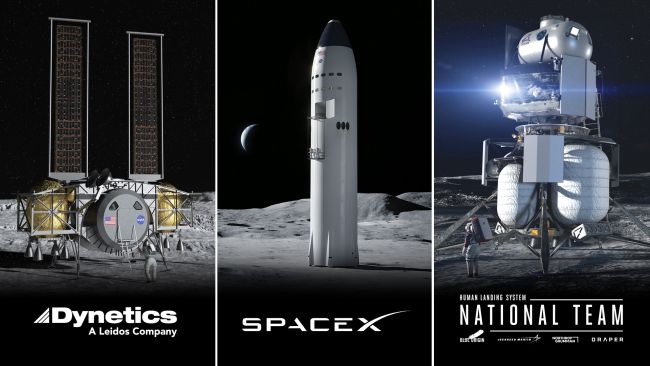
By Naveen Kumar Dwivedi
NASA selects contractors to develop, build human moon landers
(Image: © NASA)
Mission timeline
All three contractors will develop their lander concepts through the contract base period ending in February 2021, according to a news release. During that time, NASA will determine which contractors will perform demonstration missions. NASA experts with the Human Landing System program at NASA’s Marshall Space Flight Center in Alabama will work closely with the commercial partners during development. HLS program manager Lisa Watson-Morgan will assign NASA personnel to support the work of each contractor. The moon landers that 3 industrial groups area unit developing for ferry astronauts, from the satellite surface for NASA area unit a various bunch.On Thursday (April 30), NASA proclaimed that it had awarded contracts to a few industrial groups, every of which is able to develop a personality’s landing system to be used by the area agency’s Artemis program. Artemis aims to place 2 astronauts down close to the moon’s South Pole in 2024 and establish a property presence on and around Earth’s natural satellite by the late 2020s.SpaceX, Dynetics and a team junction rectifier by Blue Origin can split a complete pot of $967 million, which is able to fund ten months of development work. NASA can then tab one or additional of those groups to mature their systems. In the end, the area agency can procure crewed satellite transportation services from the choices that area unit left on the table.The options area unit, at this early stage anyway, quite varied, for the industrial groups area unit taking terribly completely different approaches to their landers. SpaceX, for instance, can continue developing its ballistic capsule deep-space transportation, that Elon Musk’s company envisions creating Mars organization and different daring exploration feats economically possible.
Dynetics: 2-person lander
Whereas Starship represents a single-stage approach to lunar landing, Alabama-based Dynetics will develop “a two-stage architecture, with a common ascent and descent element and anytime abort capability,” Lisa Watson-Morgan, Human Landing System program manager at NASA’s Marshall Space Flight Center in Huntsville, Alabama, said in a teleconference with reporters on Thursday.
Dynetics, a Leidos company, is developing the Dynetics Human Landing System, a single structure providing the ascent and descent capabilities that will launch on the ULA Vulcan launch system or NASA’s SLS.
“It has a unique low-slung crew module, putting the crew very close to the lunar surface for safe access,” Watson-Morgan added. The Dynetics lander’s crew module is designed to accommodate two astronauts on trips to and from lunar orbit, including stays on the moon’s surface of about a week, representatives of the company, which is a wholly owned subsidiary of Leidos, said in a statement. But that’s the nominal use case, the lander could also fit four fully suited astronauts on brief trips to or from the lunar surface if need be.
SpaceX’s Starship megarocket
The 165-foot-tall (50 meters) Starship will launch off Earth atop a giant rocket called Super Heavy. Both of these elements will be reusable; each Super Heavy will come back down for a vertical landing shortly after liftoff, and each Starship will fly many missions once it’s aloft, Musk has said. (Starship needs Super Heavy only to get off our planet; the spacecraft will be powerful enough to launch itself off the surface of the moon or Mars.)
Starship will be capable of carrying up to 100 people at a time, Musk has said. NASA wouldn’t come close to filling the possible seats on each Artemis flight — the 2024 landing mission, for example, will carry just two astronauts — but the agency would doubtless find a use for all of the vehicle’s space and power. (Starship will be able to haul 100 tons of payload to the lunar surface.) Thursday’s announcement deepens SpaceX’s involvement with NASA’s moon-exploration plans, which was already extensive. For example, the company is eligible to deliver robotic NASA payloads to the lunar surface using Starship, work the space agency says will help pave the way for crewed Artemis visits. And last month, SpaceX secured a contract to supply Gateway, the small space station that NASA plans to build in lunar orbit as a jumping-off point for surface missions, using an extra-large version of its Dragon cargo capsule. Gateway is an important part of the agency’s long-term moon plans but will probably not be involved in the 2024 landing, agency officials have said.
Blue Origin’s ‘National Team’
Blue Origin’s national team, which includes Lockheed Martin, Northrop Grumman and Draper, is developing an Integrated Lander Vehicle, a three-stage lander to be launched on Blue Origin’s New Glenn rocket and United Launch Alliance’s Vulcan rocket.The third team is led by Jeff Bezos’ Blue Origin, with participation from Lockheed Martin, Northrop Grumman and Draper. This group will develop a three-stage architecture, which features descent, ascent and transfer elements.
The descent stage will be based on Blue Origin’s Blue Moon lander and BE-7 engine, which the company has been working on for a few years now. The ascent stage will leverage Lockheed’s experience developing the Orion crew capsule. (Lockheed is prime contractor for Orion, NASA’s next crewed vehicle, which will carry agency astronauts toward the moon and other deep-space destinations.) Fun fact:-Do you knowwhy moon is called MOON? The second man on the moon was Buzz Aldrin.and“Moon” was Aldrin’s mother’s maiden name.